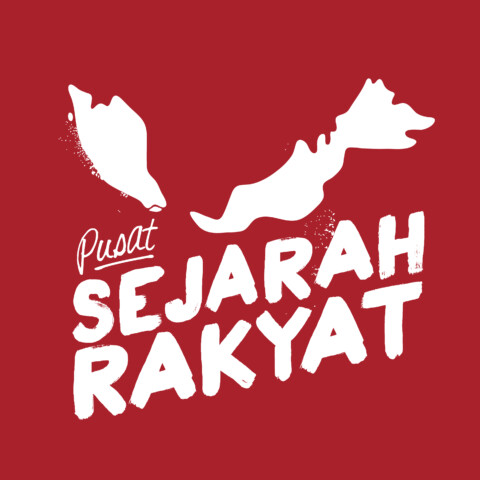Yeoh Lian Heng is an artist and cultural worker based in Kuala Lumpur, advocating against gentrification and forced eviction in multiple heritage sites in Malaysia. Starting his advocacy by wheatpasting thought-provoking artworks in his university’s lifts, he incorporates visual art and performance as a means to raise awareness on the plights of urban settlers and villagers facing the twin threats of gentrification and eviction.
Can you tell us about yourself?
My name is Yeoh Lian Heng. I’m an artist that does community work, and produces written work. I run an art space named Lostgens’s Contemporary Art Space (Lostgens).
I studied Art at the Central Academy of Art in 1999, during the Reformasi period when I came to Kuala Lumpur. I wasn’t heavily involved at that time, but I did attend some talks on Reformasi and later met people there who went on to stay friends and future colleagues. At the Central Academy of Art, I studied Fine Arts and chose printmaking as my main subject. I read about a French artist using printmaking as a medium to spread public awareness about issues in French revolutionary history and people who died, specific events, and foreign workers who are discarded when they are not needed since there were such a high number of them in France at that time. The history of factory workers is not very well known, so the artist engages with the workers to produce posters to commemorate events and stick them on factory walls.
Printmaking was not very popular when I first started, because it is a very laborious process with chemicals, machines and other equipment. It’s a pretty lonely journey since not many people are into printmaking. Nonetheless, I was fascinated with the dissemination quality and “the masses” nature of printmaking (In France, they would use printmaking in the production of graphic art and letterpress in advertising).
Art isn’t just a pretty mural on a building. Rather, art has a purpose to educate the masses and tell the story of things that happened in the past, are happening currently, and will happen in the future.
What was your first printmaking project that was for a protest in Malaysia?
Well, I started doing political art during university at the Central Academy of Art. I was still a novice, but I knew there were people in positions of power (in my university) that utilized their power to go “the path not taken”. I mostly did photostats of my drawings at that time, and pasted art in the lifts to evoke curiosity of people. Not everyone understood but it did create an impact and sparked discourse among people. Essentially, I did my first protest in school [university].
My university emphasized graphic design over fine arts. They won’t put art on the streets— just in art galleries. During my foundation, my history lecturer, Mr Baharuddin, just came back from San Francisco, and we talked a lot, suggesting that we are to create a student union, to fight back issues and policies that weren’t pro-students. He was later fired from his position, and although I was still fresh, he created some impact [in me] that lasted until today.
Can you describe that first graphic in the lift that you made?
The graphic in the lift was one of someone eating a coin, “makan duit”. I was playing around with the visuals.
Subsequently, did you remember any works that you produced for protests, whether independently or with friends?
Quite a lot. A notable one was when it was to preserve Jalan Sultan. My idea was the Moving Great Wall, in which we (friends and people of the community) drew up a 500-feet long banner to walk around the place. But the night before that, we ended up going to Dataran Merdeka and surrounded it instead. Then, in the morning, we went to Jalan Sultan and Petaling Street, which generated some interest from the public. On the banner, we wrote things like asking for mayoral elections (because of how unorganised the development in KL is, and how it makes us restless). Other than that, we wrote some things about resisting eviction in this area and how we refused to relocate elsewhere.
I wanted to expand that idea, because it was 2012 and there were a lot of protests throughout Malaysia such as the anti-Lynas and cyanide usage in Raub gold mining, to name a few. We wanted to bring the banner to these places and add 500-feet worth of banners but it didn’t happen. Indeed, art connects people, and allows everyone to express their feelings and gather people together.
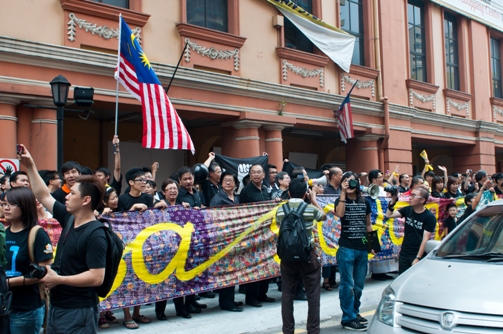
Protestors from the Save Jalan Sultan group. Source: Tan Kai Swee
You’ve been involved in quite diverse movements like urbanization, culture and heritage. When you were involved in the movement at Jalan Sultan for example, in 2012, you were also involved with the villagers of Kampung Banda Dalam* who were facing similar issues. So how did you meet up and work together with them?
What happened was that in 2004, Lostgens was set up, and one year later, Food Not Bombs KL (FNBKL), an NGO that did a lot of protests, rented a space in Lostgens. In 2006, a friend from FNBKL told me that there was a case of forceful eviction in Kampung Berembang, and KL itself had a zero-squatting policy, so a lot of forced evictions were ongoing such as those in Kampung Cempedak and in Pudu. Even though the settlements looked like slums, the residents were more akin to city settlers, such as in the case of Kampung Berembang. From what I know, the Malay urban population was rather disproportionate compared to other races so Tun Razak encouraged city settling as early as two years after Independence with the consent of the Selangor state government.
After Reformasi circa 2005-2006, development was very dense during Pak Lah’s era, and a lot of land was needed so the Selangor state and developers were cunning about getting land, like from Kampung Berembang which was in the heart of Ampang. My friends told me that they joined protests at Kampung Berembang, but when they saw the sight of the demolitions, it looked like an earthquakes just happened. Children were running all over. I was thinking how there was nothing one could do. After discussions with friends, we suggested that we could help rebuild the toilets, and since there were kids running around which were causing stress to the parents, we figured we could bring the kids together for an art workshop and create a puppet-shadow play performance— that paper puppet-shadow play could be a protest in itself because back in 2006, social media was limited.
I figured that puppet-shadow play and cultural nights could become a way for the kids to express their feelings and tell the real stories. A lot of NGOs helped out, notably Parti Sosialis Malaysia (PSM) with their strong commitment to help with their legal trouble, and after discussing with Arul (current PSM deputy president) and an informer, we figured that art could be another strategy of public disruption. In other words, we used two offensive strategies: the law and the arts.
One day, we did a performance in Penang at Mr. Ong Boon Keong’s place, who was one of the first people who protested in Penang. His organization was called Save Ourselves (SOS). In the late 1990s, the government repealed the Rent Control Act in which the renting of pre-war buildings were controlled. In light of this, rent suddenly became expensive, and it had a major effect. Those living in heritage homes were kicked out because they couldn’t afford rent, thus resulting in them sleeping on the streets and under the bridge. So, Mr. Ong gathered people to form Penang SOS.
According to him, Penangites do not normally protest, but because of Penang SOS, some of them did acts such as stopping the then Chief Minister Koh Tsu Koon’s car. Apparently some people died, especially elders who could not adjust to the new environment, which sparked the protests.
Mr Ong invited us to perform in Penang 2007. We had Fahmi [Reza] to design the posters mimicking the Visit Malaysia campaign design, and the local city council had to disavow it as “illegal.” According to the statement released by the local government, they threatened to arrest us if we were to come to Penang and proceed with performing. We discussed with the Kampung Berembang children and voted on whether we should go. We acted more like facilitators, letting the children decide for themselves rather than us older folks dictating for them. The kids still performed, so the police came but nothing happened afterward. This was the first time I strongly felt that if you have strong conviction in what you do, and if you believe you’re doing the right thing, you should continue— and I think those kids learnt the same lesson, too. One kid went to study in Ampang, and discussed the incidents of Kampung Berembang with their teacher. The teacher said, “Yeoh is my student!”, which was coincidental since that teacher is Mr. Baharudin, my lecturer.
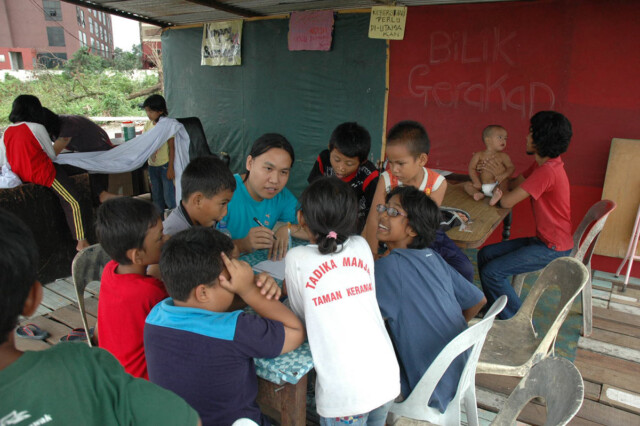
Yeoh conducting art activities in Kampung Berembang. Source: Lostgens’
What role did you play in protest movements? When did you start to join or coordinate them?
It started with Kampung Berembang. I was physically and confrontationally involved. Some individuals hit me pretty badly using chains, and it involved officers from the Ampang Jaya Municipal Council. But, they didn’t arrest me as there were plenty of students that came to defend the space. But there was a problem because of a lack ofinter-ethnic solidarity among the villagers.
Meanwhile, in Kampung Cempedak, Shah Alam, many wooden homes were demolished, and the demolition of homes happened according to different (ethnic) groups. It came in waves. The Chinese groups were the first to have their homes demolished, followed by the Indians or Malays. Initially, I did contribute ideas to the taskforce and was at the frontline, but after a while, I decided it was best for me to work in the background to mobilize the team. Nonetheless, the Special Branch (SB) officers still call me to inquire about us. I guess they got a hold of our contacts, including mine. Some people are better at the frontline of protest but those at the front have to be ready for the fact that they will get beaten up, and frankly, I wasn’t ready for that. I thought to myself, “What other role can I play instead?” I feel better being an organizer from behind since I’m artistic and have the ability to gather people.
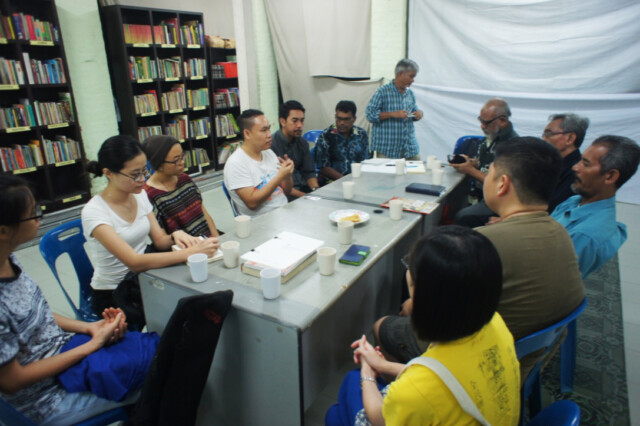
Yeoh meeting with Cikgu Ishak, the head of village Kampung Bandar Dalam and other committees. Source: Transactions in the Field
You mentioned how Kampung Berembang was like a catalyst for your physical involvement in public protests. In your experience, how would you assess the involvement of protest tactics over time?
NGOs usually go in after the demolition, but I thought why not visit sites to preempt the demolition. For example in Kampung Bandar Dalam, another group successfully defended land against gentrification and MRT construction. We were quite inspired and wanted to replicate its success in other places like in Kampung Railway.
Encampment was an option but it is hard to pull it off effectively. There were 50 families in that village, which was in a desolate state. This village was demolished 6 times, and by then, the village was barred all around. The villagers had to camp near electrical substations. We fought until they got their compensation. However, their “relocation” was supposed to be within 4km of the village but instead, the villagers were sent all the way to Puchong.
We tried different approaches at different places over time to suit the different needs. For instance, [the protest at] Jalan Sultan required a different strategy: instead of direct encampment or protests, we did festivals where the streets were occupied. We also focused a lot on public education, especially within the Chinese community, explaining our approach and reasons. Thankfully, we got some NGOs and local area churches, hotels, associations and schools to support their cause. I also proposed to emphasize the “heritage” framing as a media strategy, or media warfare.
Kampung Berembang was more physical and confrontational which resulted in a lot more physical harm and intimidation from the authorities. But as a result of this violence, it created pressure on the government since they were heading into the 2013 general election at that time. Those in power were worried since the government never faced an opponent that used art as an activism strategy. We weaponised events and festivals to raise awareness. Initially, many people including some of our stakeholders were skeptical whether art would be a viable protest strategy but in the end, we were proven right. Even the general public were drawn into the cause since it was framed as banding together in the name of preserving art and heritage.
I also want to mention how the media played an important role in affirming that this site is a heritage site for all races, not just for the Chinese community. It is a Malaysian heritage.
The government attempted to play up racial sentiment to divide people by strategically planting people that reinforce existing stereotypes within the community. But we showed them otherwise. During an event at Jalan Sultan, religious leaders of different faiths, like imams, samis, et cetera, were pictured praying together, and that was a shocking sight to see – like a powerful projection of unity. I strategised a lot with Cikgu Ishak Surin, a very forward-thinking man, on how to make Malay presence more prominent in the crowd so that their visibility is stronger. Look, when a bunch of Chinese people rally together, it’s already quite significant. But when people see that kopiah-wearing Malays are also joining in and uniting together in that rally, then people start to think the movement is even more significant.
How has protest impacted you and your friends? Has your view on protest changed?
Many of them were disappointed despite the various protests in 2013, there was no change in government. I thought of ways to find an answer, so I organised philosophy classes for about 30-40 people every Tuesday, which lasted for 6 years until the Movement Control Order (MCO). People from different fields came together, mostly Chinese people. We discussed everything, politics included. We created thinkers as a result. I felt the need to elevate the discussion, because even though the impact is not immediately visible now, it could influence others in the future. I truly do think education is important, and not just formal education, but alternative education as well. Education can come not just from books but from workshops too.
After the change of government in 2018, we are in a stage of (political) transition lasting for a few years. We don’t know where it’s heading, but we have to prepare ourselves nonetheless. Activists need to look beyond the fights in politics at the surface level. If we continue to engage (only) in such fights, we would lose time in preparing ourselves and the energy to face such transition.
Back in 2008, I believe there needed to be a third force but many joined the Pakatan Rakyat opposition…but it is we, the people, who ought to strengthen and direct that change. Don’t let the politicians bring us, because based on history, we’d be let down repeatedly. Take the example of the activist Wong Tack.
Anyway, activist friends and I have been thinking about whether the protests we were involved in bring any good— to which I’d say it’s 50/50. The impact may be further ahead. History is long, and our time is short…we can (only) do what we need to do in that short time. For example, I love printing and letterpress, so I’m doing my best to preserve it as heritage and knowledge; otherwise, it’ll be lost. My mission is focused on preservation.
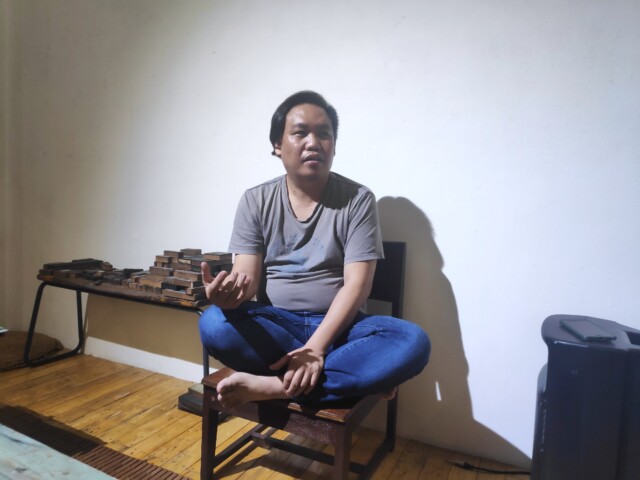
Yeoh being interviewed in the Lostgen’s comtemporary art space
Before we wrap up, any final reflection of Lostgens as a community space and network which has been instrumental to multiple protests in the past 20 years?
To me, Lostgens is an idea, not necessarily a physical space. Of course, we have a physical space now to store stuff and conduct workshops, but it can be just an idea or a medium. We are very interested in preservation. Loss happens quickly, even if something is attempted to be preserved through memories because lives can be lost quite quickly. That’s why since 20 years ago, we set up this space to continue the idea of preserving what needs to be preserved. We used to do a lot of exhibitions as a sort of archive, but I’m looking towards something beyond exhibitions. Maybe in 10 years, I’ll contribute in a different way because it’s more than just artifacts; it’s also culture, history, knowledge, and collective memory.
When Lostgens first started, we did lots of festivals attended by Malays and Chinese communities, so it is multiracial. Our performances in Chinese and Malay languages might alienate some races, but I do think this shouldn’t happen. Actually, some people might prefer Lostgens because it is perceived as purely Chinese, but for me, I try to pull my Malay friends to be involved as well. I think we definitely need to curate events to appeal to a more multiracial crowd, and consider the involvement of other races beyond Chinese. Like last year, we did an exhibition on graves and brought Malay artistes in. We cannot deny there is an racial divide in our society. Friends who study in Chinese schools have told me that their lives felt like living in parallel with the Malays, like they don’t interact much with them, so school is definitely a factor. Our society is divided along languages too, like English-speaking Malays vs. non-English-speaking Malays. I always discuss this with Soleh, a close comrade of mine. This generation needs to break the divide, because if not, the future will be tough.
Lostgens tries to bring people together, even if it is still a Chinese-majority community. This is definitely a challenge for me, because these divides have been long entrenched. It’s not something you can undo even in 10 years, but I am positive that my friends out there are good people doing their part. As an art space, I feel the need for it to be more open racially. Actually, we have some pieces in Jawi and Malay, and these pieces serve as a gateway to connecting with friends who are from backgrounds that utilise those languages. Space is just space, honestly, so if it’s not utilised, then it’s useless. One of the founders of Lostgens is a Malay actually, Lisa, but she’s already a businessperson. Other than her, Saiful Rahman, and Ili Farhana were also founders, so it’s clear that we weren’t just a Chinese-only community. It’s just that after the events in Kampung Berembang, as we became more involved in the Chinese community, our image also shifted to become more Chinese-centric.
Ultimately, the reality is that this is a multiracial country. We need to be confident that we are part of the country, and not be easily swayed by politicians and lose confidence in our sense of belonging and identity. This is why I do a lot of multiracial oral history, because I want to show multiracial solidarity and nation building.
